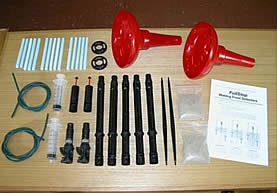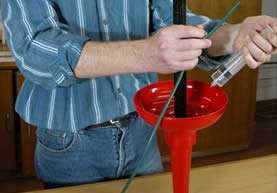







FullStop - soil wetting front detector
The new CSIRO FullStop device does two things:
1. A FullStop detects whether the soil is wetted down to the depth at which the FullStop is installed.
The FullStop Wetting Front Detector is a specially shaped funnel, a filter, a float and a flag. The funnel is buried in the soil, at a depth in or below the active root zone of the plants. When rain falls or the soil is irrigated, water moves downwards through the soil. A wetting front is the boundary between the wet and the dry soil. The water moves as thin films around the soil particles. As the wetting front moves down into the buried funnel, the cross sectional area of the funnel narrows and the water in the films is contained in a shrinking volume of soil. This causes the soil at the bottom of the funnel to get wetter and wetter. The soil becomes so wet that water seeps out of it and passes through the filter to be collected in the reservoir. This water floats a light-weight rod which in turn operates a flag above the soil surface that indicates that the soil is "full" so irrigation should "stop", hence the name "FullStop".
The FullStop has no wires, no electronics and no batteries. Water from a wetting front converges in the funnel to fill the reservoir and this raises the float. If the soil is dry before irrigation, the dry soil absorbs more water and the wetting front penetrates the soil only to a shallow depth. However if the soil is wet before an irrigation, it cannot store much more water, so the wetting front penetrates the soil to a deeper level.
2. A FullStop collects a water sample that can be used to measure the amount of salt in the rootzone
A syringe is used to extract the water-sample from the FullStop, via the 6 millimetre (mm) tube. The salinity of the water sample can be measured using an electrical conductivity meter.
 Various documents relating to the FullStop can be downloaded from the quick links and documents menu at the left.
Various documents relating to the FullStop can be downloaded from the quick links and documents menu at the left.












 Downloading Documents
Downloading DocumentsClick on the links above to download the pdf documents. Right click the link and choose "Save As" to save a copy of the file. You will need Adobe Acrobat Reader to view the files.






















